Last Updated on February 4, 2023 by Audrey Scott
What hiking essentials do I need for a multi-day hike? What gear and hiking backpack should I take on a day hike? What gear would be too much? And what hiking gear is essential so that you are prepared for all types of weather and other scenarios? How am I going to carry it all so it's not too heavy? This Ultimate Hiking Essentials Checklist aims to answer all of those questions — and much more — to prepare you for your next day hike, multi-day trek or outdoor adventure.
It's no secret that hiking and going on multi-day treks is one of our main loves in travel. We've gone hiking on all continents, from the top of Tanzania to the jungles of Colombia, and over the years we've become quite adept at packing efficiently and effectively for treks of all lengths and weather conditions. Our goal in figuring out the best hiking essentials and gear is to be prepared for changing weather, but to still pack light so we're not carrying a lot of weight.
After receiving numerous emails, queries and comments asking about how we prepare and pack for these multi-day and day hikes, we decided to assemble our hiking essentials checklist with our favorite gear and advice for hikes, long and short.
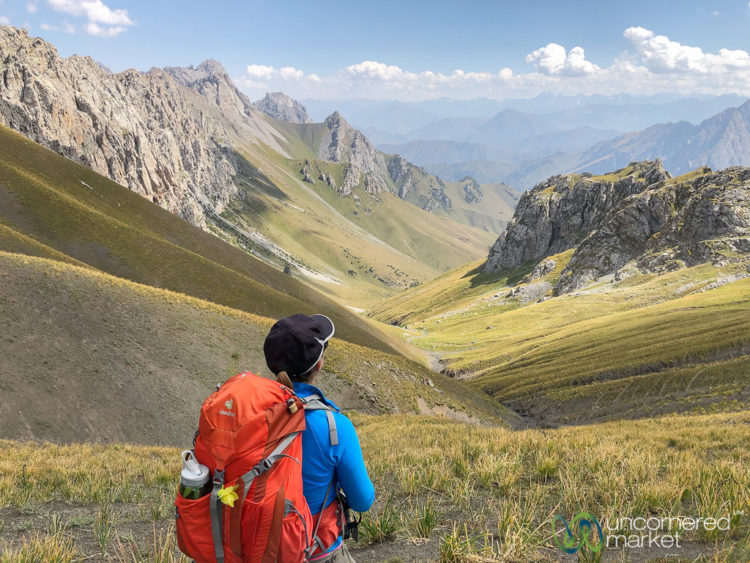
By way of background, during the first six years of our journey we carried all that we needed in our backpacks so as to be prepared for just about any kind of climate or activity, from beach to glacier. In retrospect, we made some silly decisions in those early days. As a result, we carried a few bits of gear we never used.
But through experience and experimentation and after about a dozen multi-day treks in all types of weather and altitudes, we got smarter and more effective in our packing for hikes. This isn't only regarding what hiking gear to carry with us, but also when it made sense to rent gear locally for the duration of the trek or even to buy the gear on the ground.
And we figured out how to do all this while on a budget.
What is the difference between trekking and hiking?
Good question. While this article does a good job breaking it down, for our purposes here we're using the two words somewhat interchangeably to represent going out and walking in nature for a period of time. This is different from mountaineering that usually involves specialized climbing gear and technical skills and backpacking that usually involves camping gear.
Note: The following advice applies mainly to multi-day hikes where your sleeping and eating arrangements are taken care of already (think guest houses, lodges, tea houses, home stays, yurts or even with a trekking agency that takes care of carrying your tent and food). If you are camping on your own, then you'll need to add food, camping, and cooking gear to everything below.
Update: This article was originally published in June, 2014 and updated last in May 2022 with additional gear and tips that we've learned from additional day hikes and multi-day hikes we've done during that time (e.g., Alay Mountains in Kyrgyzstan, 10-day Huayhuash Trek in Peru, a winter trek in Bhutan, hiking in Cyprus). We've added a section on winter trekking gear, a note on sustainability when thinking about hiking gear, and an updated Ultimate Hiking Essentials Checklist.
This article is long and covers a lot of different topics and types of hiking gear. Use the Table of Contents below to find the information and section that best suits what you're looking for and your needs. If the hiking gear that we originally bought and use is no longer available, we will find and recommend the closest current option.
Hiking Gear Myths: Don't Make The Same Mistakes as Us
We've made a lot of mistakes with hiking gear and packing for hikes over the years. Here are some of the trekking packing myths that we've discovered along the way.
1. You must purchase the latest and greatest hiking gear.
It's true that some trekking clothing technology is especially useful for lightness, wind-resistance, waterproofing and wicking (GoreTex, fleece, Polartec, etc., come to mind). However, we suggest focusing on the hiking gear essentials: clothing that is comfortable, breathable, light, easily layered.
You're not climbing to the peak of Mount Everest here. (If you are, that's for a different article altogether). For a little perspective, watching locals breeze by you in flip-flops might make all your fancy hiking gear seem a little unnecessary.
There's no need to overspend. Go for good quality so you can use it for a long time, but resist the shiny bleeding-edge hiking gear toys. I know it's hard. Outdoor stores are dangerous shopping vortexes for us, too.
2. You need to bring EVERYTHING with you.
For almost every multi-day hike we've undertaken, there's been ample opportunity to rent or buy gear to supplement our regular hiking gear kit. For example, it's just not practical for us to carry around bulky sleeping bags in our backpacks when we only need them a tiny fraction of the time during a trip.
Do your research and find out what is available on the ground and at what cost. Ask the tour company you're going with or reach out to other independent travelers who've experienced the same hike. When you land on the ground, shop around for the best price to rent or potentially even buy something used or new.
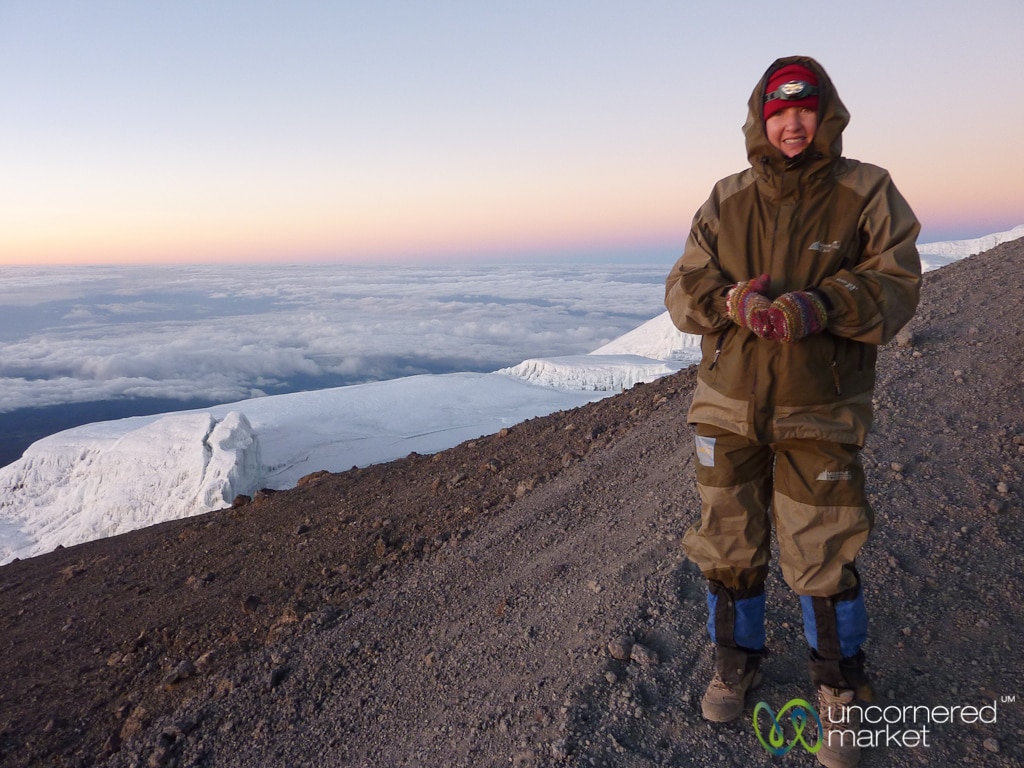
Before climbing Mount Kilimanjaro, we'd traveled through Bali, Malaysia, Bangladesh, Jordan and Thailand — all with the same gear in our backpacks throughout.
So it was more than worth the $65 I spent in Moshi, Tanzania to rent a sleeping bag, waterproof pants, waterproof jacket, walking stick, gaiters and more to get me to the summit of Mount Kilimanjaro. Dan even rented hiking shoes for $15 which offered a little more ankle support and stability than the ones he'd been wearing.
When we departed for our safari just after the Kilimanjaro trek I could just drop all that stuff off at the trekking gear shop and continue with my regular light backpack.
3. Real treks require camping.
This is all subjective. It's true that camping and carrying all your own gear may give you a greater sense of independence and accomplishment and allow you to dive deeper into nature. However, we take issue with the assertion that camping equals a better hiking experience.
In fact, some of our most memorable hikes (e.g., Annapurna Circuit, Markha Valley Trek, Svaneti, Peaks of the Balkans, Kalaw to Inle Lake in Burma, etc.) have been memorable precisely because of the local culture and human interaction dimensions surrounding our sleeping and food arrangements with local families.
It's the combined experience of nature and people (and the human nature that responds to the surrounding environment) that we find truly soul nourishing.
READ MORE: 13 Best Offbeat Treks That You’re Not Considering…But Should
Packing for Your Hike: Hiking Essentials Principles
When it comes to packing for a hike in an efficient way so that you have maximum flexibility with minimum weight, we follow the following hiking essentials gear and packing principles and philosophy. This has come together over the last fifteen years with all the different treks we have done all over the world.
1. Hiking clothing: it's all about the layers.
This is true in all types of travel, long-term and short, but especially for hiking into high altitudes. Temperatures can change very drastically during the course of a day. I always prefer to have an extra layer in my bag than to go cold or wet.
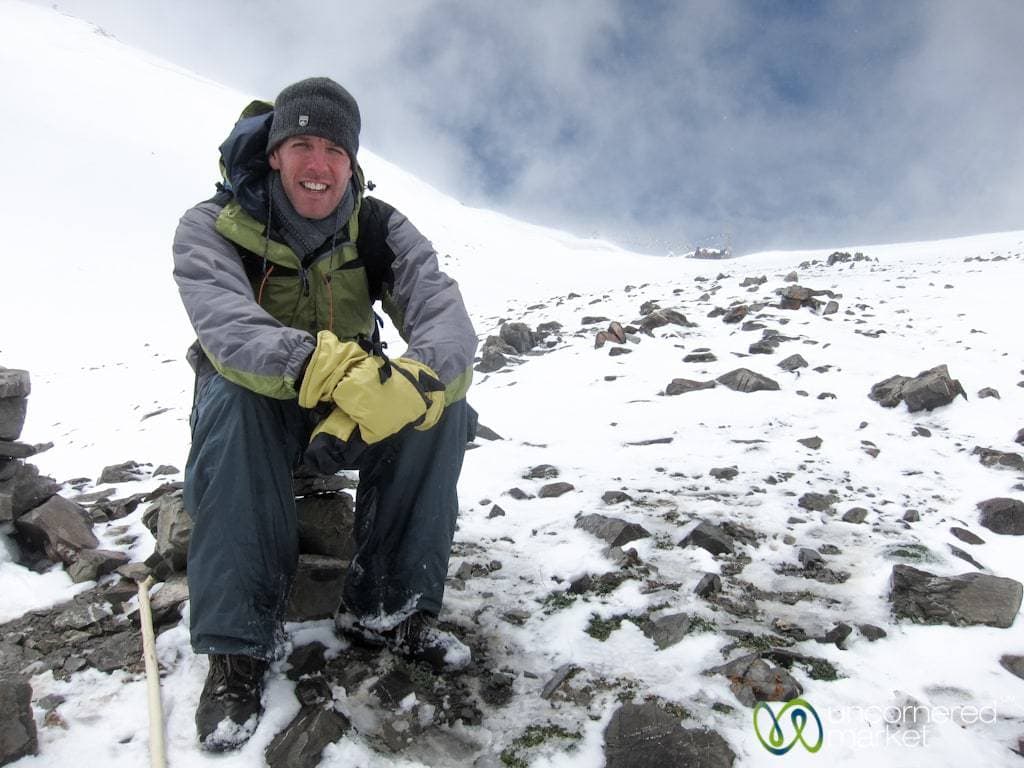
Even if the days are warm at low altitude, nights may still be chilly. On summit days you'll often need to pile on everything you have to get to the top, only to peel it off layer by layer as you descend.
2. Hiking clothing for overnights: carry separate rest and sleeping clothes.
I learned this from the folks at Erratic Rock in Puerto Natales near Torres del Paine National Park in Chile.
They called the yucky, stinky clothes you'll find yourself wearing every day until the very end your “hiking uniform.” In light of this — and even if you are going minimalist — try to include an extra set of night clothes to change into at the end of the day to relax and sleep in. These clothes will be dry (quite important if you've hit snow or rain that day), comfortable and relatively clean (in comparison).
I usually pack an extra t-shirt, pajama pants and socks. I'll further layer other clothes on top to stay warm at night. Regardless, the layer closest to my skin is dry and relatively fresh.
Oh, the little joys while on the trail.
This technique also gives your wet and stinky clothes a chance to dry and air out overnight. The next morning you can slip back into your hiking clothes — yes, your uniform — and you'll be ready to go for another day on the trails.
3. Never skimp on sun protection.
As you advance higher in elevation, the sun becomes scary strong. So even if you tan beautifully on the beach without any sunscreen, be sure to pack ample and strong sunscreen once you head into the mountains. Carry a hat that will protect your face from the sun (think rollable foldable sun hat or baseball cap — we don't need to look pretty while trekking).
Hiking with sunburn — face, neck, or hands — is miserable. And if your sunburn is bad enough, you'll almost feel flu-like. Not good for peak performance.
Also be sure to have sunglasses with quality lenses that protect your eyes. Otherwise, they too will become burned and sore.
Choosing a Hiking Backpack
You’ll be carrying all your stuff on your back up and down mountain passes so the size, fit and comfort of your hiking backpack is super important. Aim to carry a hiking backpack that is big enough to hold the essentials (e.g., water, jacket, rain gear, sunscreen, etc.), yet not too big that it will weigh you down.
The size of your hiking backpack will depend on the number of days of your hike is, your sleeping and eating arrangements, and temperatures. No matter what, don't forget to bring a rain cover to protect your backpack in storms.
In the early days of our travelers we often repurposed our laptop backpacks or rented backpacks from trekking agencies. This usually did the trick, but they did not always fit use entirely and thus were not very kind to our back and shoulders.
We've since invested in proper hiking backpacks and haven't looked back. Our only regret is that we wish we had done this earlier to save ourselves some of that early discomfort.
Here are the hiking backpacks we're now using and can recommend for comfort, weight, size and convenient features.
Recommended women's hiking backpack
I really do love my Deuter ACT Trail Pro SL hiking backpack (32-liters) and take it with me every chance that I have. It's very light with all sorts of great functionality like a built-in rain cover, water bladder compatibility, wide waist belt for stability, and more. The SL means that it's designed for women's bodies and I don't know how much of a difference that makes, but I find that it does fit my back and body quite well.
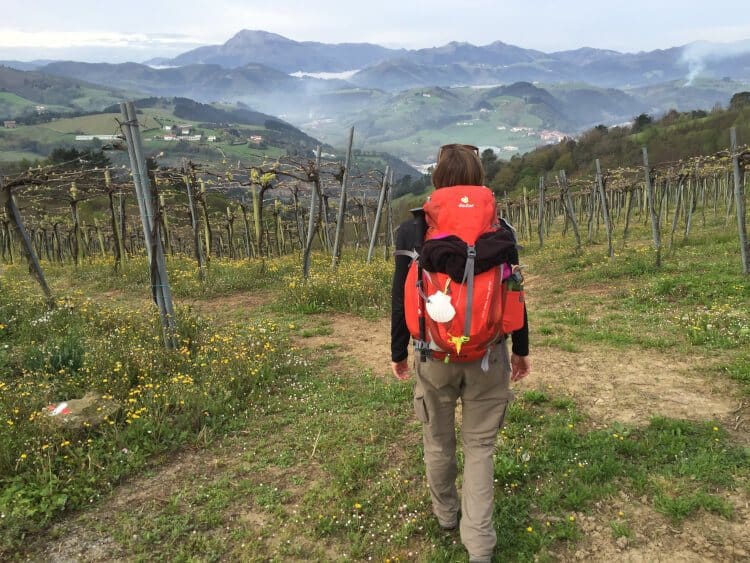
Even after walking almost 1,000 km / 600 miles with it on my back during the Camino de Santiago, I still found it comfortable and had no issues with it. I've used this hiking backpacks both on multi-day hiking trips as well as on day hikes when I wanted to carry several layers of jackets and rain gear, a water bladder and other hiking essentials. Although it is a bit big for a traditional day pack, I still find it comfortable and light enough to serve this purpose.
Deuter no longer makes this backpack in 32 liters, but you can still find it or similar Deuter SL hiking backpacks in other sizes. Buy on Amazon (28-Liter) | Buy on REI (22-Liter) | Buy on Backcountry.com (34-Liter)
Recommended men's hiking backpack for multi-day hikes
The Osprey Exos hiking backpack comes in several sizes, so the Large version is well-suited for tall people (like Dan). Light, comfortable, and durable. This was the first hiking backpack that Dan used that didn't leave him with a sore back and shoulders at the end of the day.
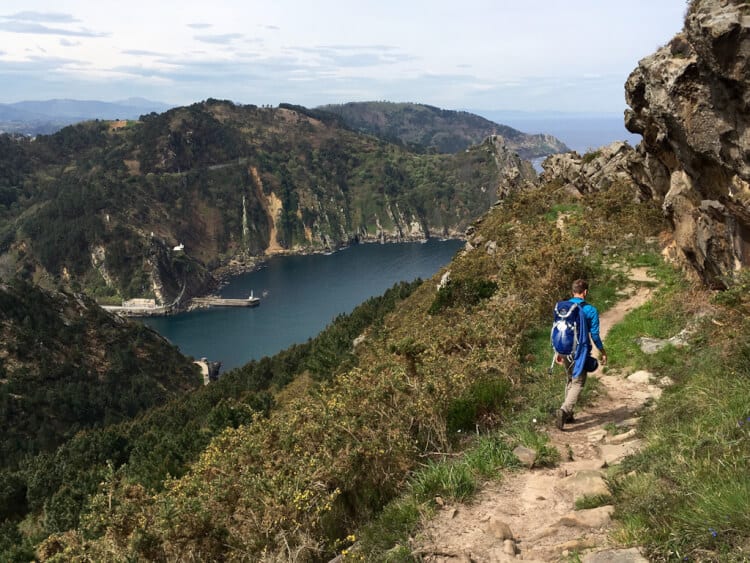
The only complaint about this backpack is the walking stick holder as it's a little janky, but that's a small thing compared to comfort and all the other great features of this Osprey hiking backpack. Buy on Amazon | Buy on REI (48-liter) | Buy on Backcountry
Recommended men's hiking daypack
As you know from above, Dan is a big fan of Osprey packs as they are adjustable and fit his back and torso well. So when he was looking for a smaller size daypack he stuck with Osprey and chose the Osprey Packs Stratos 24. This 24-liter size is great for day hikes or as a daypack on multi-day treks (e.g., when most of your hiking gear is carried by mules). Buy on Amazon | Buy on REI | Buy on Backcountry.com
Hiking Clothes for Men and Women
Below is an overview of the hiking clothes we each carry for a 5-10 day hike. If you are going on a shorter trek then you can cut back, but if your hike is longer you can still carry the same amount of clothes or even less (e.g., we carried a similar amount for our 40-day Camino de Santiago walk).
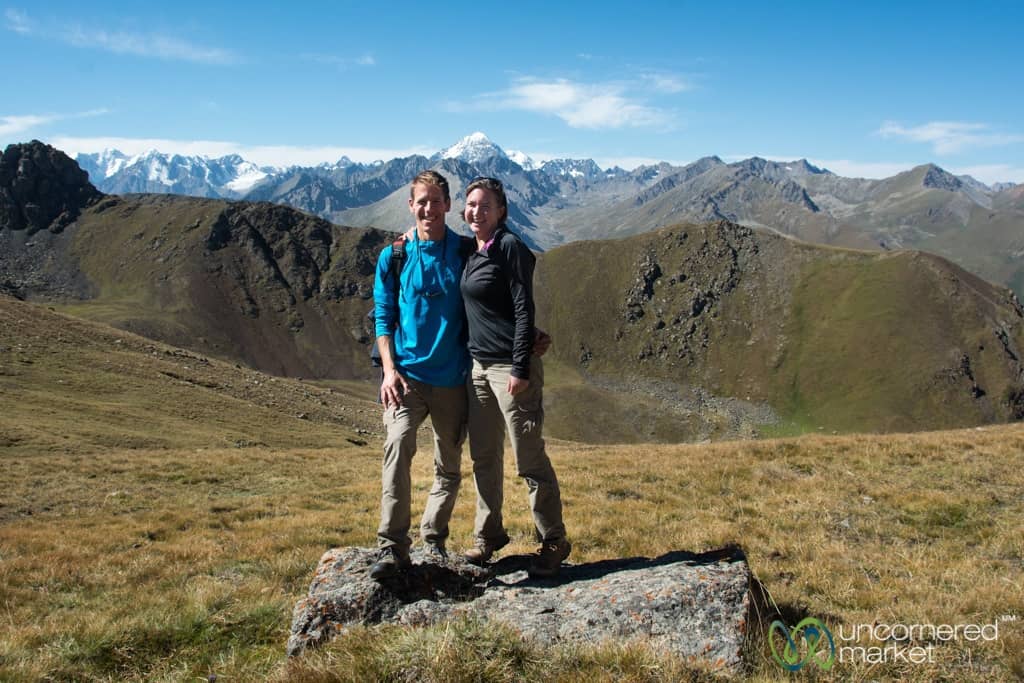
For longer hikes and treks you'll just need to “recycle” your hiking clothing more or find a way to wash them along the way. By recycle, I mean turn things inside-out, air them out, wash them. Whatever the best mechanism you have available to give it longer life and whatever your tolerance level might be. The most important thing is not whether you stink (there's a good chance you just might), but that you are dry and comfortable.
My approach is to carry and maintain separate hiking and sleeping (or relaxing at night) clothes so that you always have something clean(ish) to change into at night (see above for more details on this).
To be on the safe side to protect against things getting wet, put your sleeping clothes and whatever else you aren't wearing at the time in Ziploc or another kind of plastic bag.
Hiking Clothing: Base Layers and Mid-Layers
Hiking pants (one pair): We're both been using Clothing Arts Travel Pants (men's hiking pants and women's hiking pants) for over ten years on all of our day hikes and multi-day treks. These hiking pants are not only are sturdy (we've put them through a lot and they still look great), but they are also quick-dry and avoid stains and odors.
We find the additional secure zipper and buttoned pockets useful on treks for keeping phones, money, tissues and other things handy. (Note: This is especially relevant for women as many women's trekking pants hardly have any pockets of any size.)
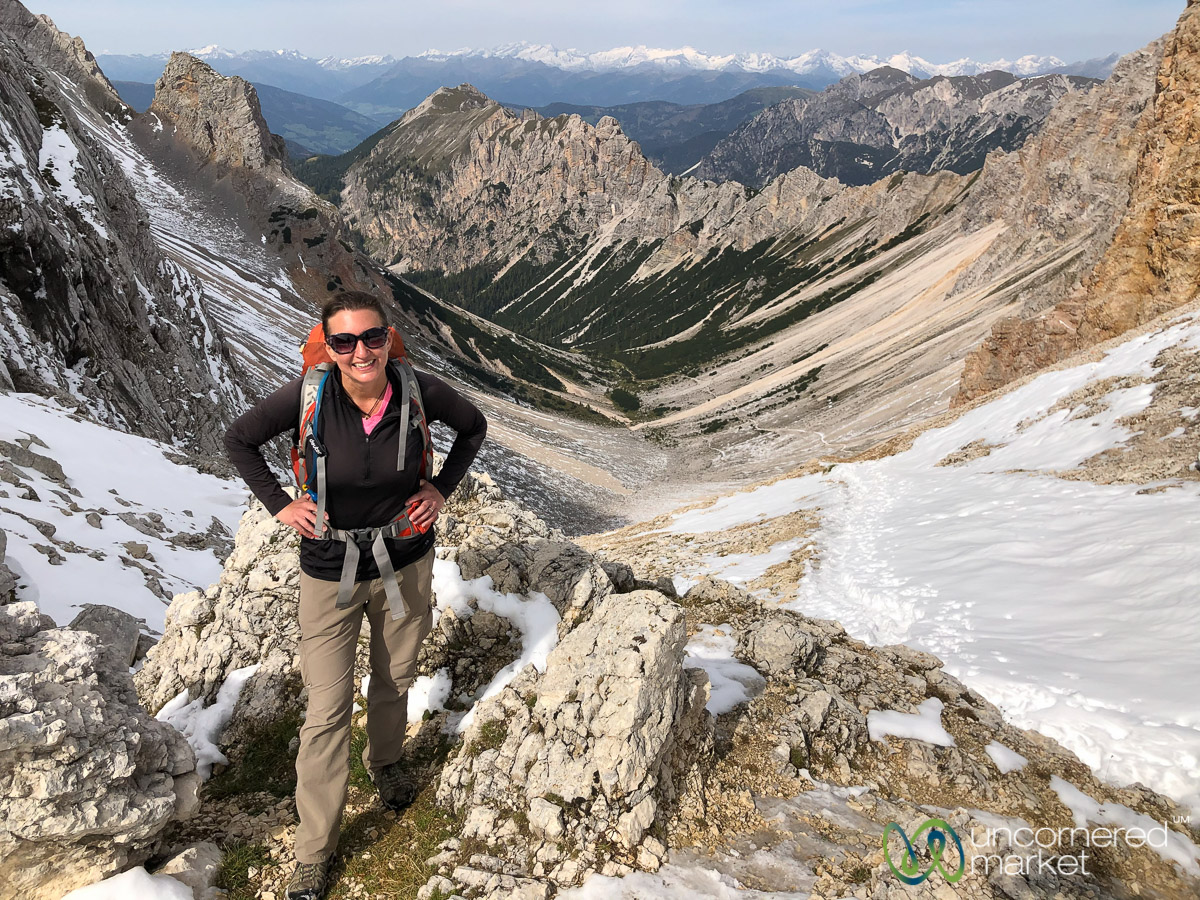
Thermal underwear (top/bottom): I love my silk long johns as they are warm, comfy and take up almost no room at all. Also good is Uniqlo's Heat Tech collection of thin, but warm, layers of leggings and tops. Dan is still keen on his Patagonia zipper top and bottoms that he's been using for over 20 years.
2-3 short-sleeved t-shirts: Preferably quick-dry or regular cotton for comfort and versatility. We often use our running shirts on hikes as they are light and wick away sweat well. Plus, the bright colors of the shirts allow us to easily find each other when we're hiking at different speeds.
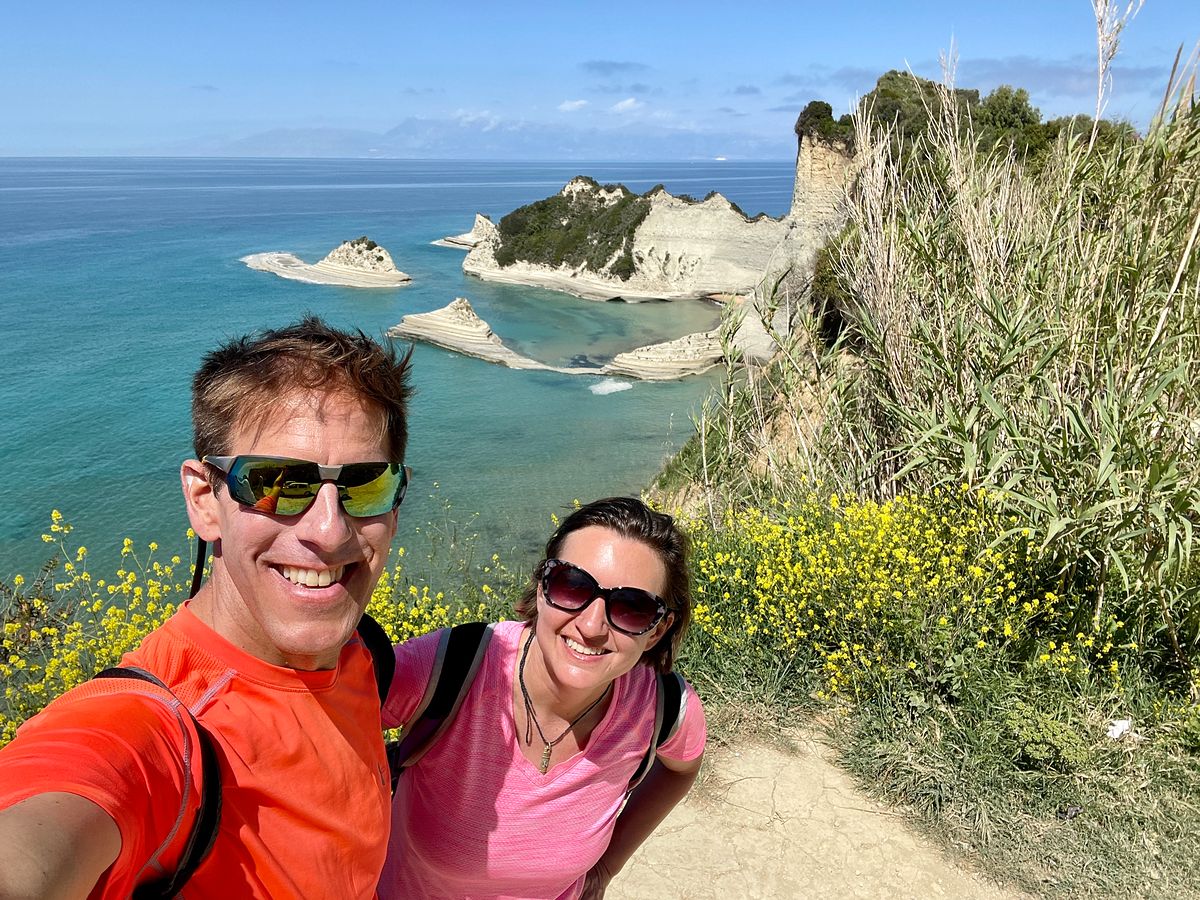
1 long-sleeved pullover or zipped shirt: When you need another light layer to go over your t-shirt for cold or sun protection. I've been enjoying a light zipped top for women and Dan's been using a half-zip pullover.
Pajama/sleeping pants: I find that cotton leggings or yoga pants work quite well.
Hiking Socks and Underwear
Underwear: However many pairs that you're comfortable with carrying. Underwear is light and doesn't take up much space so you have some flexibility here. Here are recommended men's boxer shorts and women's underwear.
3 pairs of socks: I love SmartWool hiking socks. Not only are they comfortable, but my first pairs lasted me almost seven years of very heavy usage. If you prefer a thinner sock check out their ultra-light line. Buy at REI | Buy on Amazon | Buy on Backcountry
Hiking Outerwear: Jackets and Waterproof Gear
I always prefer to have the option to remove layers than to not have enough to put on when I'm beginning to chill as I head over a mountain pass or through a storm.
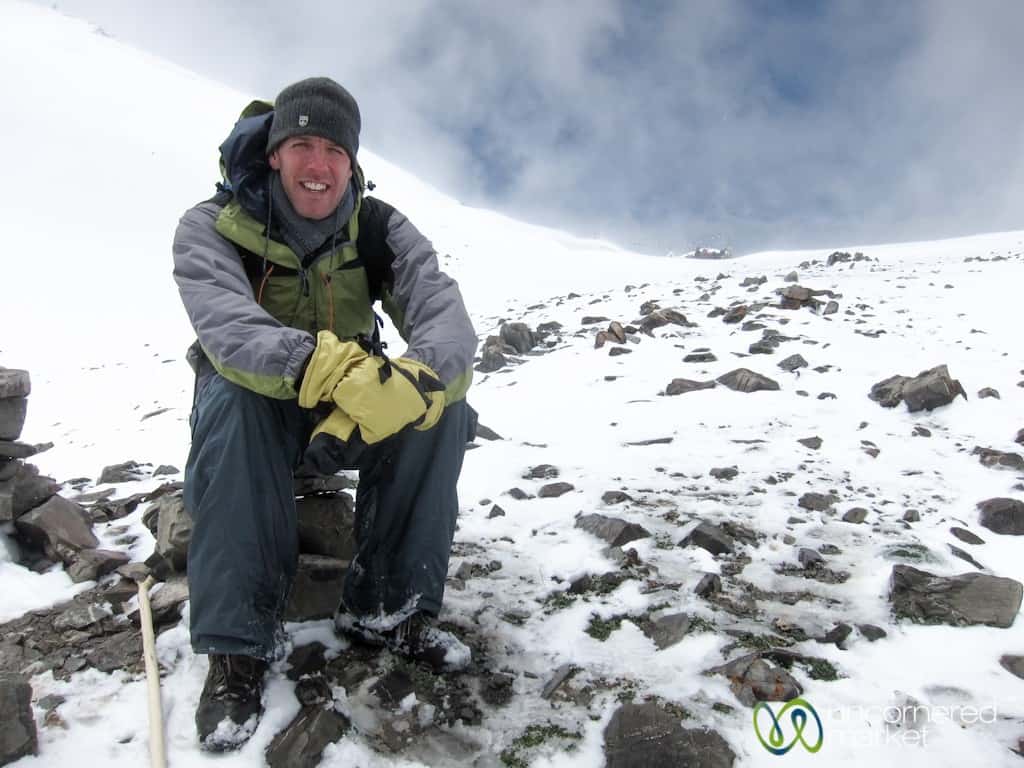
Waterproof Shell Jacket and Pants
For jackets, we each usually bring a light fleece jacket, thin windbreaker and some sort of outer waterproof or water resistant jacket.
Waterproof Jacket: For our recent trek in Peru I upgraded to a NorthFace Climatech technology waterproof jacket and I love it. It not only provided protection against the rain and cold, but the jacket material is very breathable so it didn't feel like a sauna inside. Highly recommended. Buy at REI | Buy on Amazon | Buy on Backcountry
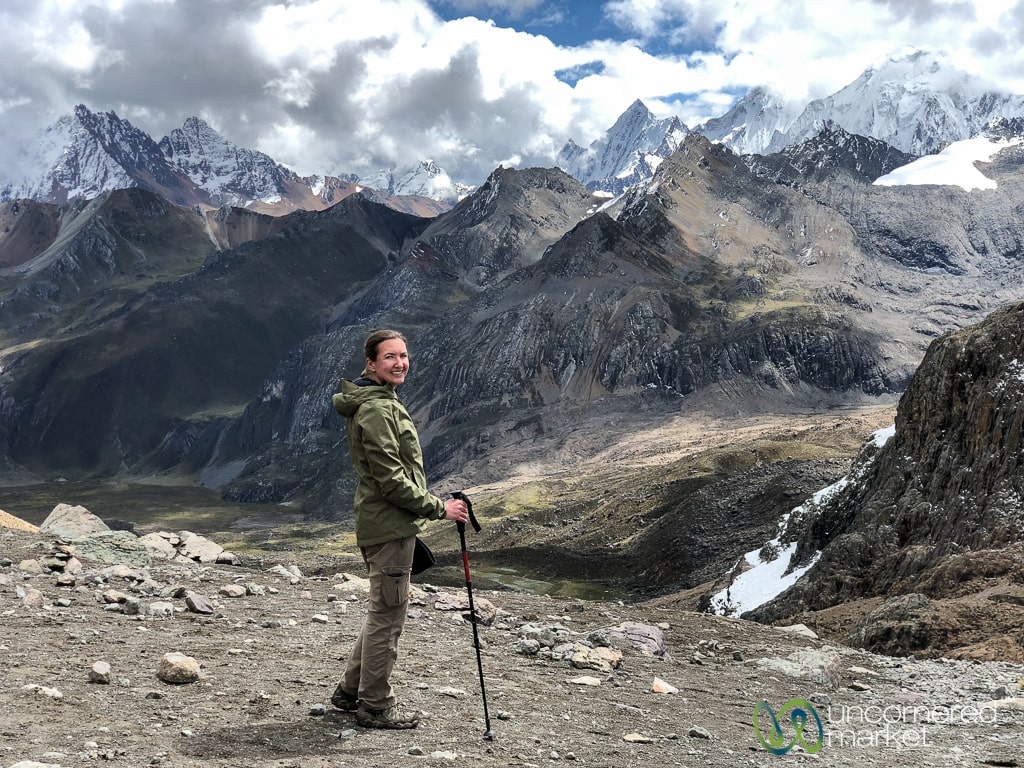
Waterproof Pants: We used to borrow or rent waterproof pants from a local trekking agency, but most recently we picked up a pair of light pull-on biking waterproof/water resistant pants. They fold up into a small bag so they barely take up any room or weight in your backpack, but keep you quite dry when the clouds open up.
Waterproof Poncho: If we really think we're going to be facing a lot of bad weather we'll also pack a waterproof poncho that goes over our hiking backpacks for extra protection. It can get steamy under the poncho, but it's worth it for that additional layer to keep you and your gear dry.
Light Down or Puffy Jackets
We've also started carrying a light down jacket that can be stuffed into a tiny cinch bag. It hardly takes up any room or weight in the backpack, but can provide warmth and comfort at night when temperatures drop. Dan loves his seamless ultra-light down jacket from Uniqlo. I carry a down jacket similar to this that packs up small and light.
Hiking Shoes and Other Footwear
Shoes may be the most important thing you bring with you so if you invest in one thing in advance, invest in a solid comfortable pair of hiking shoes. And break them in. Your shoes can literally make or break a trip.
Hiking Shoes or Boots
If you have a particular trek or hike in mind, ask in advance whether you need mid- or high support hiking shoes for ankle support as this may influence your purchasing decision. We don't find ourselves often needing high support boots. However, if your ankles are weak or susceptible to turns and sprains, more support is better than less.
We both recently shifted to wearing Oboz Sawtooth hiking boots. The insoles and support for your feet are really good, and the shoes are sturdy and can stand up to some tough terrain. In addition, Oboz plants a tree for every pair of shoes sold so you can feel good that your purchase is going towards reforestation and environmental projects.
Men's Obuz Sawtooth Hiking Shoes: Buy at REI | Buy on Amazon | Buy on Backcountry
Women's Obuz Sawtooth Hiking Shoes: Buy at REI | Buy on Amazon | Buy on Backcountry
Flip flops or river shoes
At the end of a long day of walking you may want to take off your hiking shoes and give your feet a rest. But you'll still need something on your feet to go to and from the outhouse or nearest bush. That's where flip flops or river shoes worn with socks (yes, ignore the fashion police) are perfect.
Outside of these situations, you may find river shoes either useful for crossing or fording rivers. Depending on the bottom surface of the river and the depth, we've also just managed in bare feet, but river shoes protect your feet from stray rocks and make the crossing more comfortable.
Women's Teva River Shoes: Buy on Amazon | Buy on REI | Buy on Backcountry
Men's Teva River Shoes: Buy on Amazon | Buy on REI | Buy on Backcountry
Other Hiking Gear Essentials
Sleeping and Drying Off Gear
Sleeping Bag Liner: Arguably non-essential, but nice to have. Whether staying in home stays with provided bedding or sleeping in a rented sleeping bag, you sometimes wonder when the last time anything was properly laundered. And you may also wonder about bed bugs and other critters. That's where a sleep sack with a pillow wrap comes in to provide a clean layer between you and everything else. Our preference is for a silk liner as it is very light, but keeps you quite warm and dries quickly. Buy on REI | Buy on Amazon | Buy on Backcountry
Note: We do not usually carry a sleeping bag with us as we prefer to rent one locally if we need one. This saves us a lot of room in our luggage.
Quick-Drying Travel Towel: Always good to start and end your day by washing your hands and face. Don’t expect hot showers on treks, nor running water of any kind. But on a few occasions we've been able to get a couple of bucket baths that were really, really nice. Buy on REI | Buy on Amazon | Buy on Backcountry
Silicone earplugs: A good night's sleep on the trekking trail is supremely important for your condition. And although you may be sleeping in the middle of nowhere, there are still noises from roosters, howler monkeys, birds, lions, and not least other trekkers that will all conspire to keep you up. That's where earplugs come to the rescue and help shut it all down to silence.
Trekking Poles and Walking Sticks
Walking stick: Highly recommended on most treks, especially for steep downhill sections. Two walking sticks or one, you ask? We'll usually share one walking stick set of two so each of us uses one stick. However, using two walking sticks will provide you with more stability. This set of reasonably priced travel-friendly walking sticks fold up easily for luggage and assemble quickly when on the trail.
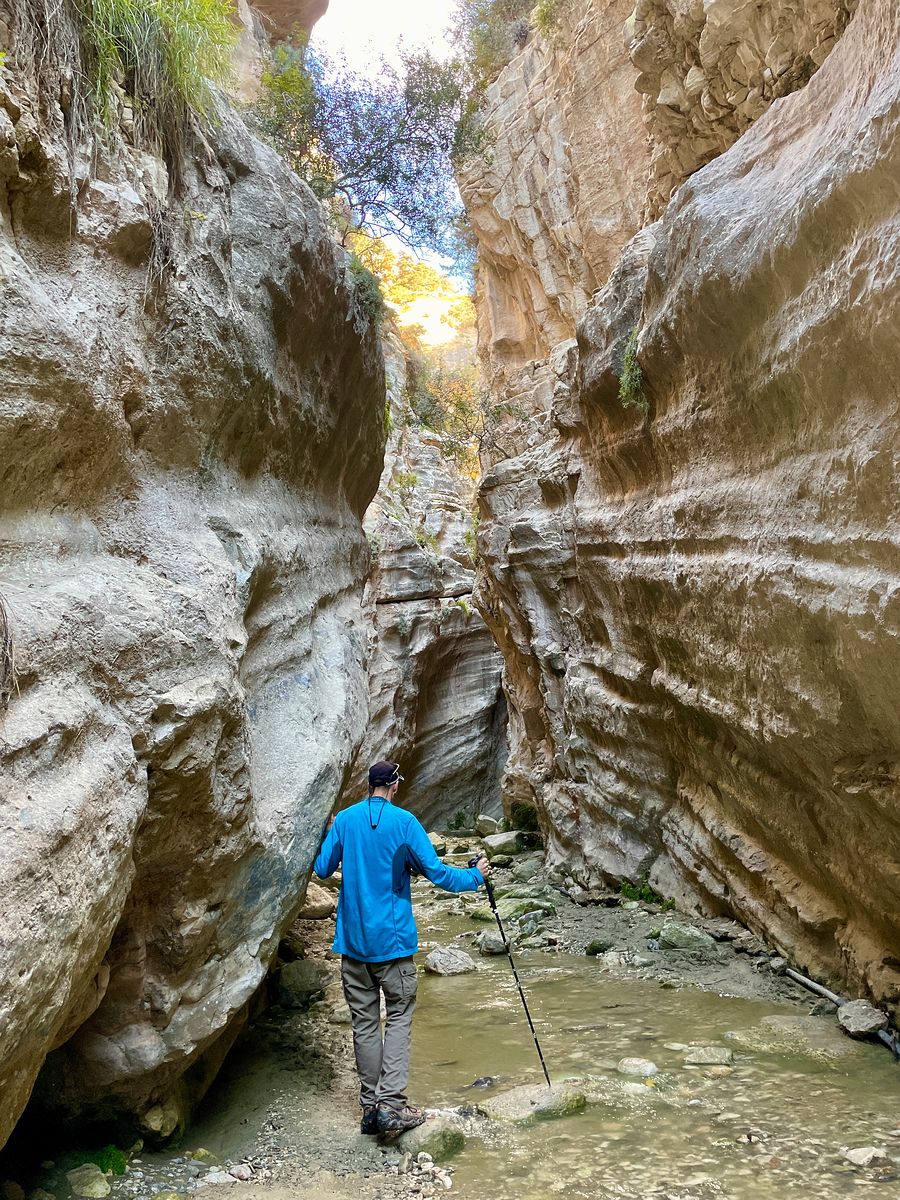
If you don't bring a walking stick with you, then keep your eye out for a tree branch or limb that can be carved for the purpose. We've done that plenty of times as well.
Sharp Knife and Lights
Leatherman: A multi-tool device with a knife, bottle opener, screwdriver, and more comes in quite handy when on the trail. We use ours all the time for cutting cheese, vegetables, bread or other food items for picnic stops. Note: remember to take it out of your carry-on bag when you fly!
Headlamp: Lights the way and keeps your hands free. If you're staying with families in guest houses or home stays, you may find they are without electricity at night or in the bathroom/outhouse, a most unfortunate place to trip in the dark. If you're camping, headlamps are of course absolutely essential.
Water and Filtration
Reusable water bottle: We each carry a reusable liter water bottle on us and refill along the way with purified or clean water. We also usually carry CamelBak water bladder in the backpack as well as we find we drink more water this way as it's easy to access and you can easily hydrate while walking.
Even if your trek has bottled water to sell, resist the urge to buy it. Plastic bottle waste is an enormous problem at elevation and in villages around the world. If you get tired of the taste of regular water, consider adding some electrolytes to it.
Water Purification: Some treks will provide you with clean, boiled water as part of the service (e.g., Kilimanjaro, Markha Valley). Sometimes there will be a program of UV (ultraviolet) purified or pass-filter cleaned water services in villages where you can refill your bottle with clean water for a small fee. Hop on it, maybe even pay a little extra. It's worth it to you, the village, and the environment.
On other treks it's up to you to somehow purify or clean the water you source from mountain streams or village taps. We suggest carrying either a water bottle that has its own purifier, a SteriPEN or sterilization drops/tablets. We've found this 2-part water sterilization drop system to be good and doesn't make the water taste too much like chemicals.
The SteriPEN uses ultraviolet (UV) light and technology to purify the water which does not affect the taste so it still might taste funky even if it's clean. The sterilization drops may make the water taste a little funny, but it won't make you sick.
Sun Protection
Sunscreen, hat and sunglasses: Bring the highest SPF sunscreen you can find and wear a hat at all times. The sun's rays are exceptionally powerful at altitude and you'll find yourself especially exposed when there isn't a cloud in the sky.
Moisturizing skin cream and lip balm (with SPF): Creams and moisturizers may sound extraneous, but they can make a difference. Many mountain treks involve high desert where you will not only be exposed to lots of sun, but also arid conditions.
Your skin and lips will dry and crack to discomfort if you don't keep them moist. Treat them nicely: moisturize! And be sure to carry only a tiny lightweight container, not the original 32 oz. tube!
Personal Hygiene Items and Toiletries
Hand sanitizer gel and soap: One of the best ways to avoid becoming ill: wash your hands thoroughly and often. If you feel a little obsessive compulsive with the hand cleaning, that’s a good thing.
Toilet paper / tissue packets: One roll, used sparingly. Better to be self-sufficient here. No explanation needed. I often also keep a pack of tissues in my pocket as well for such emergencies.
First Aid Kit and Medicines
Basic first aid gear we recommend packing: Band-Aids, aspirin/Tylenol, rehydration/ electrolyte packets, anti-flu powder (a packet that dissolves in water that breaks fevers may work better than a pill if someone has been throwing up),
Foot care: Address any hot spots or blisters the moment you begin to feel them as they can get painful really quickly. Our go-to gear for preventing and treating blisters include duct tape (magic in preventing and managing blisters) and Compeed (magic when you already have blisters).
Medicines: You may be miles or days away from any doctor so be sure to have some basic medicines with you in case you (or others) fall ill. On our treks, we've picked up sinus infections and helped others who have picked up the wrong kind of gut bacteria. Having some basic medicines with us like Amoxicillin (or other basic antibiotic) has allowed us to deal with medical issues immediately and to keep going.
For a full list of travel medicines and how to use them, check out these travel health tips.
Note: You can easily stock up on medicines at pharmacies in many countries. Basic medicines such as the ones listed here and in the article above will likely not be very expensive and will often not require a prescription.
Other Useful Hiking Bags
Dry sack: You never know when it's going to rain or snow, so prepare for the worst — particularly if you have gear that must remain dry. We carry a dry sack with us in order to protect our gear against freak storms or inadvertent submersions while fording rivers. Buy at REI | Buy on Amazon | Buy on Backcountry.com
Camera Bag: If you're carrying a separate camera and multiple lenses consider packing a separate camera bag to protect your gear and to allow you easy access to it.

Recently, we switched to a mirrorless Fuji camera and lenses. One of the main reasons for this was that they are smaller in size and weight, meaning I could carry a smaller camera bag on treks. I really like the ThinkTank Sling Camera Bag which fits a camera body and two lenses. Its shoulder strap is useful for urban settings while the waist strap makes it comfortable for hiking as it sits right on my hips. I can still wear a backpack or daypack that rests on top of it.
Hiking Snacks and Food
Snacks: Even if your meals are provided to you on a trek, it’s sometimes nice to have a little something to nibble on between stops. We usually bring a small stash combination of Snickers bars, granola/power bars, a jar of peanut butter and crackers. You'll want a little bit of both salty and sweet foods.
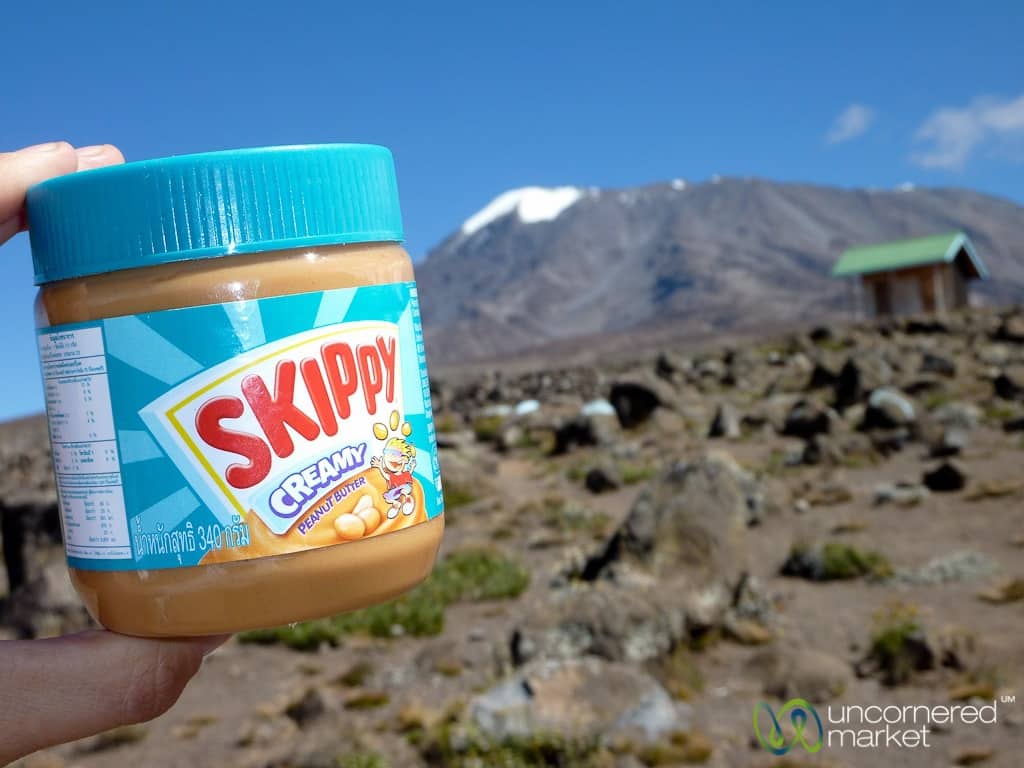
Electronic Gear and Chargers
Batteries, memory cards: It's usually better to assume that you won't find electricity along your trekking route. If you do, consider it gravy. Be sure to ask your trekking guide or agency, or other route-experienced travelers (either in forums or once you are on the ground). Ask them all once, then again for good measure. Bring extra memory cards for your camera so you have ample space to snap away or record video.
This means you should try to bring extra batteries for your camera, headlamp, and anything else that's battery-powered. If you're carrying your smartphone with you consider bringing a solar powered power bank and putting your phone on Airplane Mode to preserve battery life. We also use a battery case for our iPhone as this will usually provide 2x of the phone's regular battery life. And, it protects the phone if it is dropped accidentally.
If there's electricity along your trek and you'd like to recharge, by all means bring rechargers. We do. But it's just something else to pack — and something you must prioritize when the final bag stuff begins just prior to setting off.
READ MORE: Ladakh Trekking: A Beginner’s Guide
Winter Hiking Gear
We recently did our first proper winter trek — The Druk Path in Bhutan — and needed to gear up specifically for those conditions. This included temperatures going down to -10 C /14 F at night (and it felt even colder than that), potential snowfalls and walking on snow and ice.
However, daytime temperatures were quite pleasant and warm (15 C / 65 F) when the sun was out. So, we had to be prepared for all types of temperatures and conditions.
Winter Sleeping Bag
If you are doing a winter trek it is very important that you bring a warm sleeping bag so that you are not uncomfortable in your tent at night. We highly recommend buying or renting a sleeping bag that is COMFORT rated to -10 C/15 F (or even more). Even if you don't trek during the winter some places still get very cold at night and in the early morning. It's better to take off layers or unzip the bag than to not be warm enough. Trust us, being cold in your tent sucks.
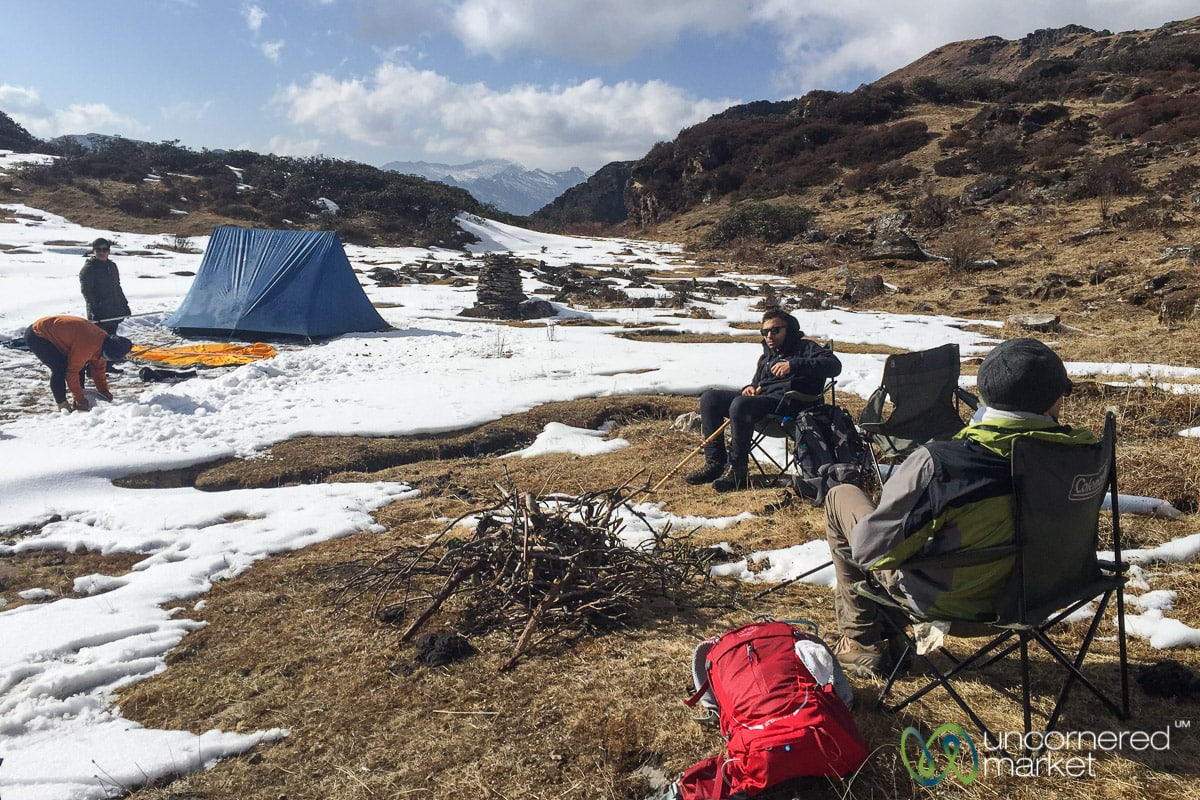
We always prefer to rent our sleeping bags locally, but for our recent winter trek in Bhutan that wasn't an option so we had to bring our own. We purchased this Mammut Nordic OTI winter sleeping bag, which was warm enough, synthetic (vs. down, which requires more care) and came at a great price. However, it's a bit bulky and took up quite a bit of space in our luggage. (Here's a similar Marmot winter sleeping bag that is comfort-rated to 0F)
Another good sleeping bag option would be one of the down sleeping bags offered by Hyke & Byke (e.g., this sleeping bag goes down to 0 degrees F) as they are very reasonably priced for down and the quality of the bags. Here are some other winter sleeping bags offered at REI.
Winter Hiking Clothing and Gear
We didn't really change our clothing packing strategy or items listed above based on having lots of different clothing layers. Instead, we just added more — and heavier — layers together at one time for the early hours of the morning and in the evening after the sun set when temperatures were the coldest. Then, as we started walking and the day warmed up we'd take the layers off bit by bit.
This mean that our day backpacks always had several layers of clothing inside, including rain gear (jacket and pants), fleece and other light jackets, and a down jacket.
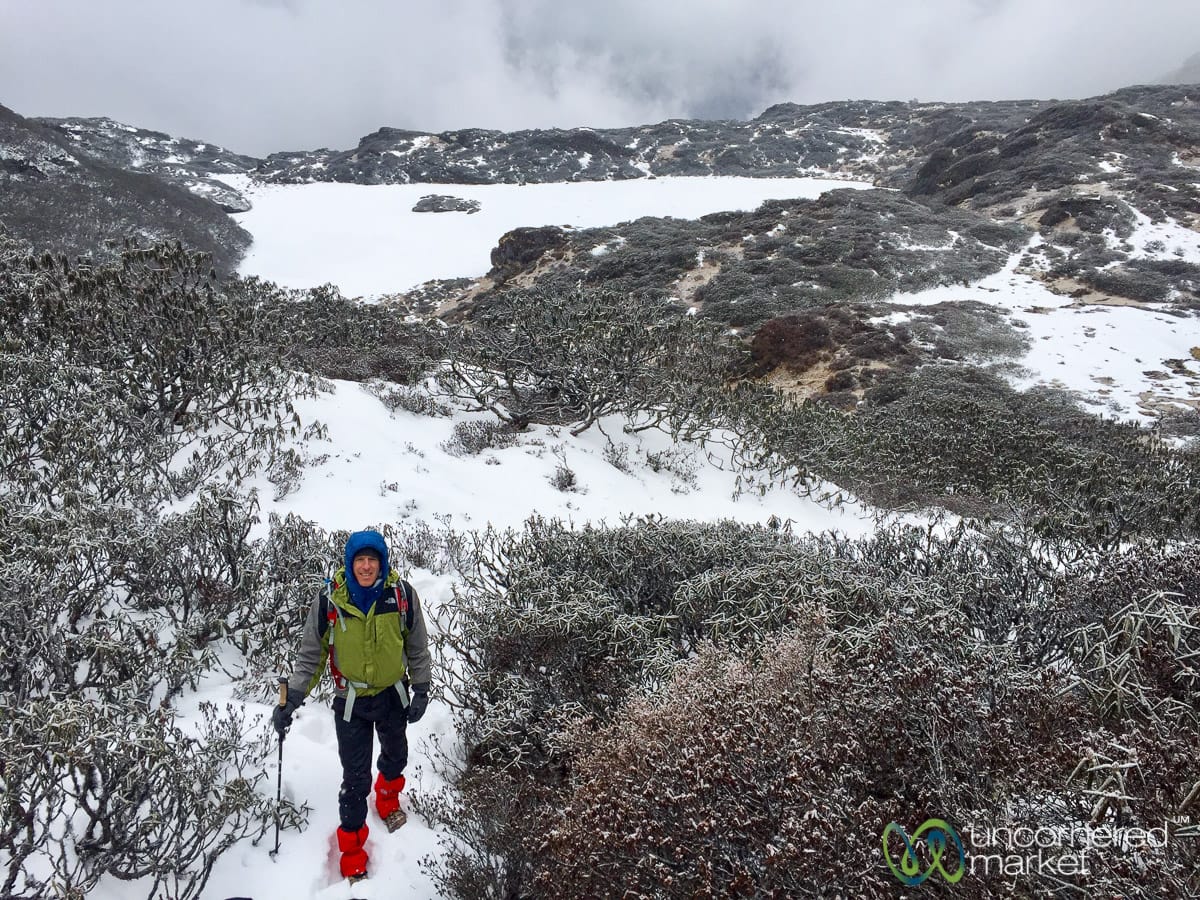
Here are a few other pieces of winter hiking gear we'd recommend, especially if you know there will be snow and ice on the trail.
Shoe gaiters: We picked up a knock-off North Face pair of gaiters in Paro, Bhutan before our trek to protect our shoes from getting wet from the snow on the trails. We were very thankful to have them, especially on day 3 when we woke up to a snow storm. Buy at REI | Buy on Amazon
Crampons or Traction Cleats: If you're doing the winter trek and have fears of slipping on the ice, carrying a pair of lightweight traction cleats can provide peace of mind. Buy on Amazon | Buy at REI
Waterproof gloves: The only thing worse than cold hands are wet, cold hands. It's important to have waterproof gloves (or mittens) if you think you'll be trekking during a snowfall or rain. Buy on Amazon | Buy at REI
Hand or toe warmers: If your hands and feet get cold easily consider bringing a pack of adhesive hand and/or toe warmers. One of the women in our group in Bhutan had bad circulation and she used these adhesive warmers daily in her shoes and gloves. They were a lifesaver and really helped keep her warm and comfortable. Buy on Amazon | Buy at REI
Winter sleeping clothes: Even if it's cold in the tent I'll change into separate sleeping clothes as it feels cleaner and better to me. For winter conditions this meant heavier base layers, including a long-sleeve Uniqlo HeatTech shirt and warm leggings (or fleece-lined running tights worked really well). Then, I added to that a fleece jacket, socks, hat, and scarf to stay warm during the night.
Buying Sustainable Hiking Gear and Clothing
If you are concerned about sustainability here are a few considerations and things to think about regarding buying sustainable hiking gear and clothing:
- The most sustainable option is the one you already own. If you can reuse or repurpose a piece of clothing, backpack or other piece of hiking gear that is already in your closet, this is usually what is most sustainable as you don't need to purchase anything new. We realize this may not be particularly fun or sexy, but it is practical and also good for your budget.
- Buy second-hand hiking clothing and gear. There are more and more options available for purchasing high quality second-hand or “barely used” clothing and hiking gear, whether through 2nd hand or consignment shops or in online marketplaces. This is another great way to shop sustainably as you are reusing something (and perhaps preventing it from going in a landfill) vs. buying new (that takes a lot of resources).
- Buy from brands focused on sustainability and fair wages: If you can't meet your hiking essentials needs through the suggestions above, then purchase your hiking clothing and gear from brands that are grounded in sustainability in terms of sourcing, materials used, fair wages, packaging and more. Do research on your favorite brand's website to see how specifically they are tackling sustainability in their operations and products. For example, Patagonia has been a leader in sustainable practices and materials for decades. Not only that, but their products do tend to last a long time (Dan using his Patagonia long underwear for 20+ years is proof of that) and they also have a strong repair policy. Another brand whose clothing we like that is focused on sustainability is Prana. These are just two of many outdoor gear brands who are making good products that also focus on minimizing their negative impacts (e.g., environmental) and maximizing their positive ones (e.g., socio-economic). If you can't find the information you want on a brand's website then contact them directly and ask your questions. Any company truly focused on sustainability would be proud to respond with transparent answers.
The Ultimate Hiking Essentials Checklist – PDF Download
To help you pack and prepare for your next hike with all the right gear, we've created a simple one-page downloadable hiking packing checklist.
I know from experience when I haven't used this list that I have accidentally forgotten to pack a scarf, hat or river shoes. I really missed these items when I was out on the trail, but by that point it was too late. Now we're more careful to review that we have everything we need before going to the airport.
How to use this ultimate hiking essentials checklist:
- Print out a copy or save a version to your phone (that's what we do now).
- As you're preparing for your hike or trek, review the list to see if you have everything you need already. If not, the linked items on the list go to recommended gear that you can purchase online or look for in a shop.
- When you are ready to pack for your hike or trek, put all your trekking gear on the floor and go through the list one by one. Double check that everything is there before placing it your suitcase or backpack.
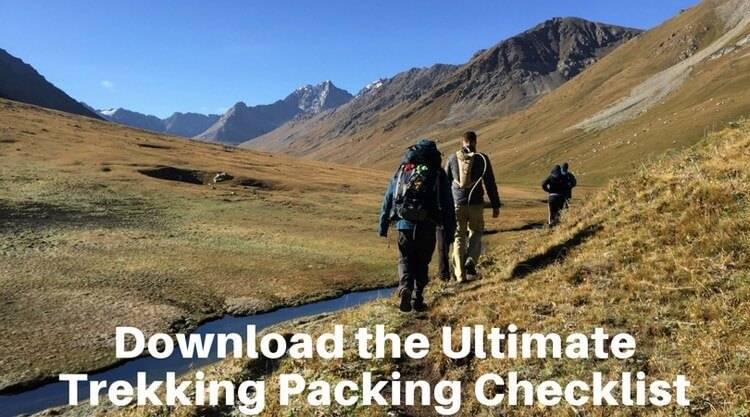
What did we miss? What are your go-to items and essential gear for hiking?
The post How to Pack For A Hike: The Ultimate Hiking Essentials Checklist appeared first on Uncornered Market.
----------------------------------------------------------------------------------------
By: Audrey Scott
Title: How to Pack For A Hike: The Ultimate Hiking Essentials Checklist
Sourced From: uncorneredmarket.com/how-to-pack-for-a-trek/
Published Date: Wed, 25 May 2022 09:45:00 +0000
Did you miss our previous article...
https://rsssuperfeeds.com/travel/the-ancient-heart-of-40-years-old






